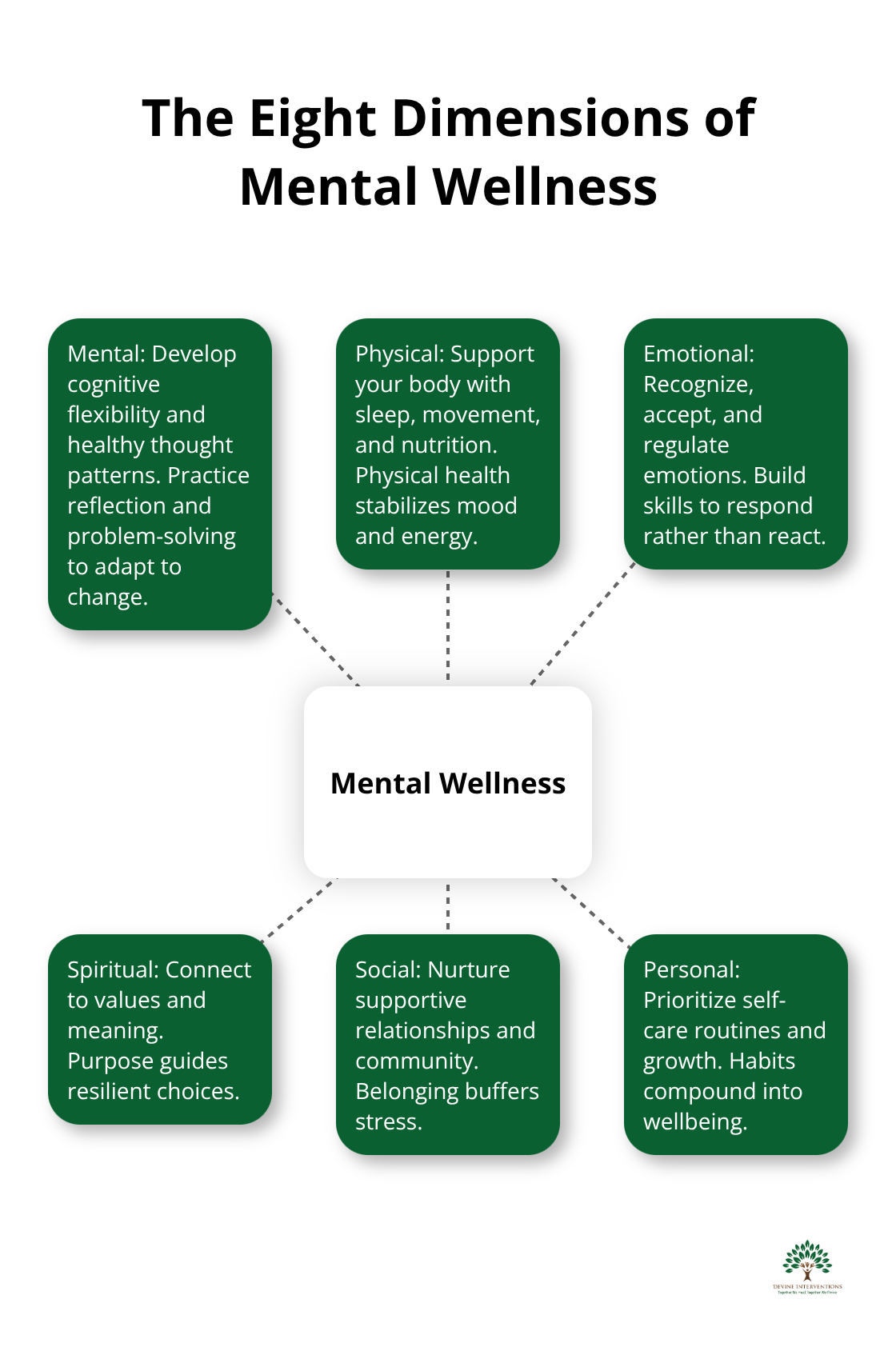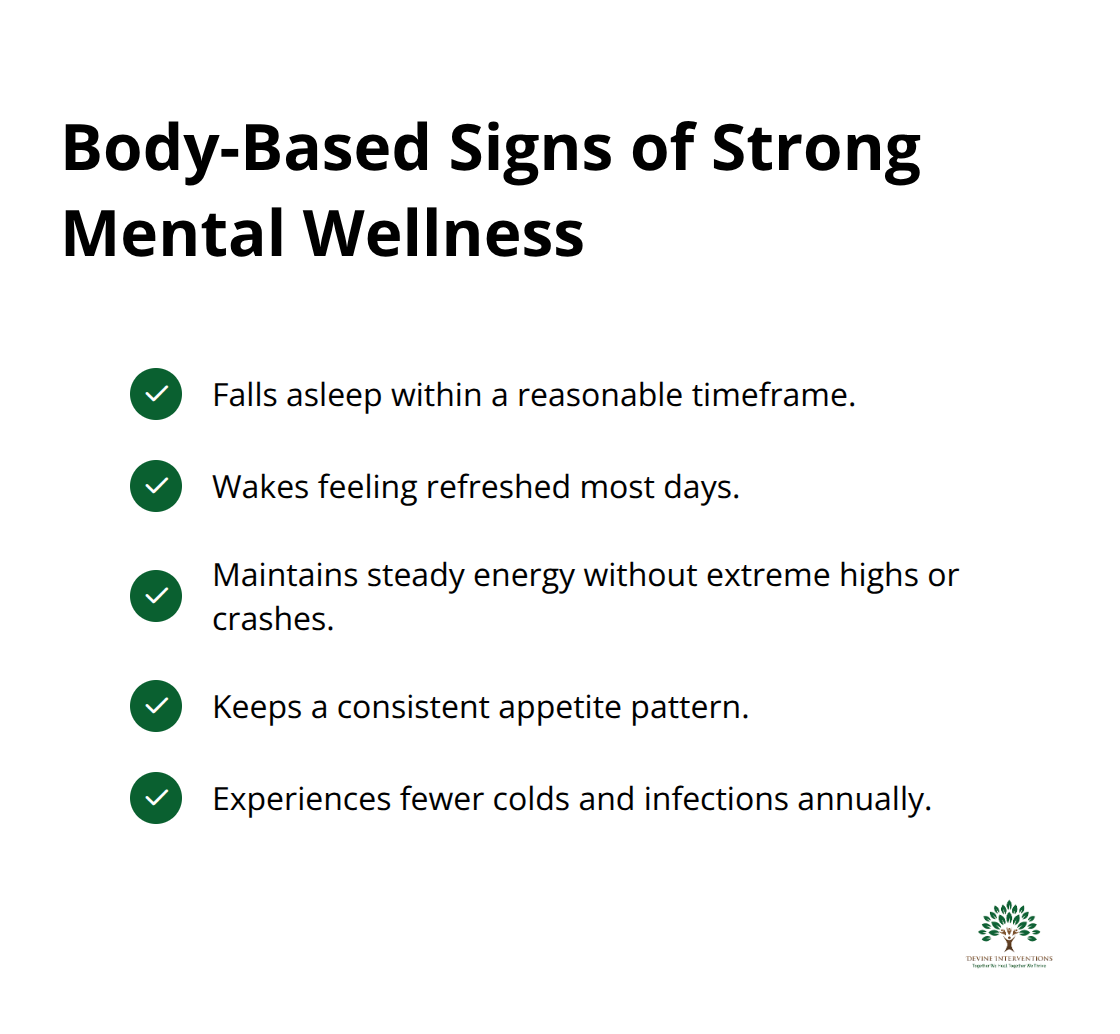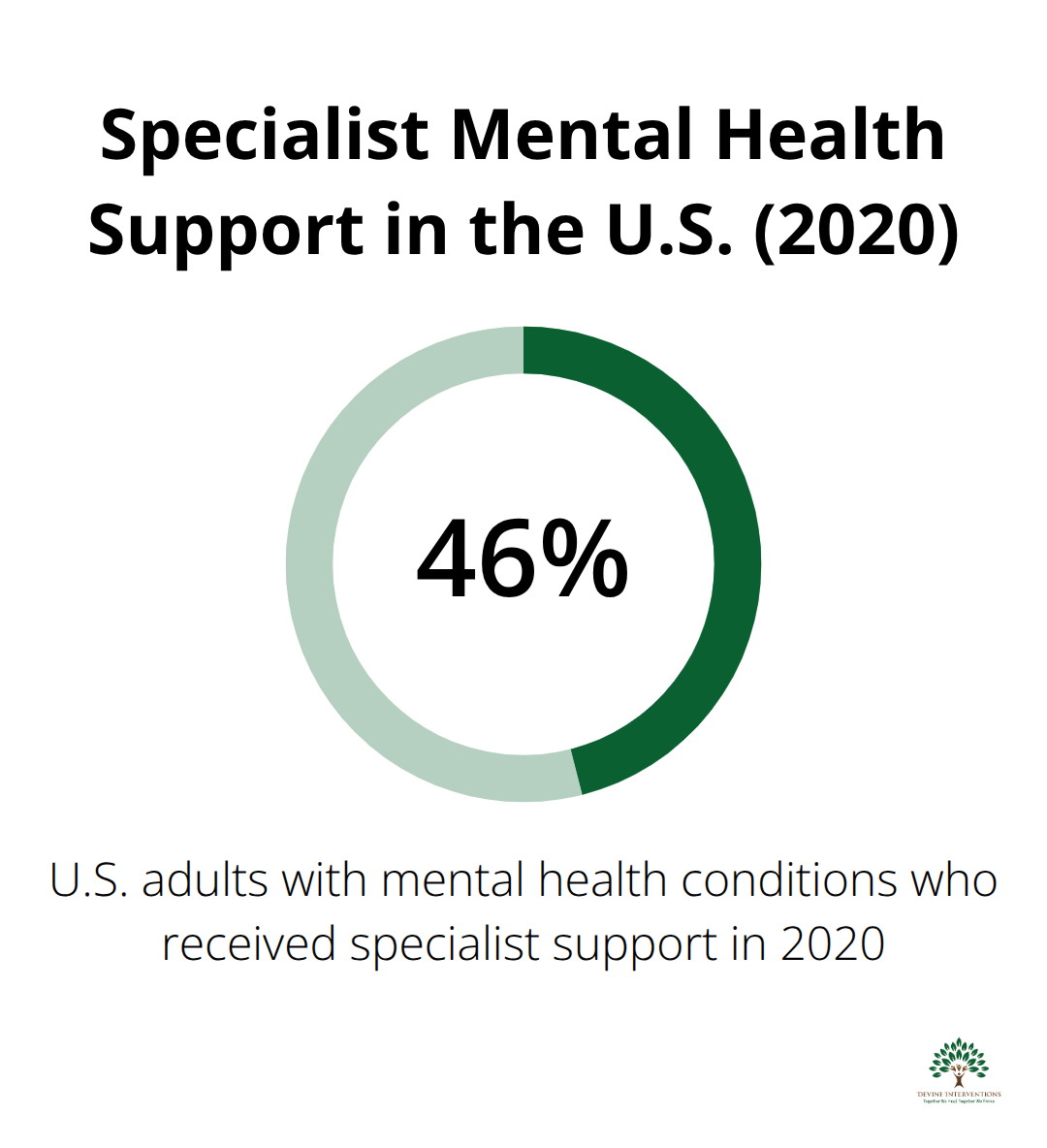Mental wellness goes far beyond simply avoiding mental illness. It represents a state where you actively thrive emotionally, socially, and psychologically.
Many people struggle to recognize what mental wellness actually looks like in daily life. We at Devine Interventions believe understanding these signs can transform how you approach your mental health journey.
This guide explores the real characteristics of mental wellness and practical steps to achieve it.
What Makes Mental Wellness Different from Mental Health?
Mental wellness operates as an active state of flourishing rather than simply the absence of symptoms. The National Institute of Mental Health data shows that 59.3 million adults experienced mental illness in 2022, yet many who didn’t fall into this category still struggled with low-level anxiety, relationship conflicts, or felt stuck in life. Mental wellness means you don’t just survive-you actively manage stress, build meaningful relationships, and adapt to life’s challenges with confidence and purpose.
Mental Wellness Requires Active Engagement
True mental wellness demands daily practices and conscious choices. Research from the Journal of Personality and Social Psychology demonstrates that people who practice gratitude daily show measurable improvements in well-being and happiness. This isn’t about positive thinking-it’s about developing specific skills like emotional regulation, stress management, and social connection. Mental wellness means you can handle a difficult conversation at work without it ruining your entire week, or you can bounce back from disappointment without spiraling into self-doubt.
The Eight Dimensions Work Together
Mental wellness encompasses eight interconnected areas: mental, physical, emotional, spiritual, social, personal, professional, and medical wellness. Research shows that regular physical activity can reduce depression and anxiety symptoms. Your sleep quality directly affects your emotional processing abilities, while your social connections significantly reduce anxiety and depression risk. When one area suffers, others compensate-but sustained wellness requires attention to multiple dimensions simultaneously.

Common Misconceptions Create Barriers
Many people believe mental wellness means constant happiness or never experiencing negative emotions. This misconception prevents people from seeking support when they need it most. Mental wellness actually includes experiencing the full range of human emotions while maintaining the ability to regulate them effectively. Another dangerous myth suggests that mental health struggles indicate personal weakness. The American Psychological Association confirms that biological factors, genetics, and environmental stressors all contribute to mental health challenges (none of which reflect character flaws or lack of willpower).
These misconceptions often mask the real signs that indicate when someone has achieved genuine mental wellness-signs that become clear once you know what to look for.
How Do You Recognize Mental Wellness in Daily Life?
Mental wellness manifests in specific, measurable ways that extend far beyond momentary good feelings. Health authorities recommend emotional regulation techniques such as eating healthy and exercising regularly to reduce psychological stress. You demonstrate emotional regulation when you acknowledge frustration without letting it control your actions, or when disappointment doesn’t spiral into weeks of self-criticism.
Emotional Resilience Shows Up Daily
People with strong mental wellness bounce back from setbacks within days rather than months. They identify their emotional triggers before these triggers escalate into larger problems. You notice this resilience when you can have a difficult conversation without it affecting your sleep, or when work stress stays at work instead of following you home.
Your Body Reveals Mental Wellness Status
Physical indicators provide the most reliable evidence of mental wellness. Quality sleep patterns serve as the foundation – people with good mental wellness fall asleep within reasonable timeframes and wake refreshed most days of the week. Your energy levels remain stable throughout the day without extreme highs and crashes. You maintain consistent appetite patterns without stress-related overeating or loss of interest in food.

Tension headaches, digestive issues, and chronic muscle tightness often disappear when mental wellness improves. People with strong mental wellness demonstrate better immune function, experiencing fewer colds and infections annually.
Relationships Mirror Your Mental State
Mental wellness becomes most visible in how you connect with others. You can set boundaries without guilt, express needs directly rather than hope others will guess, and handle conflict without attacking character or withdrawing completely. The Harvard Study spanning 80 years found seven top factors that predict happiness, health, and general flourishing, with mental health and wellness being closely tied to relationship quality.
People with strong mental wellness maintain close relationships where they can be authentic. They repair relationship damage through honest conversations rather than avoid difficult topics. Social connections provide significant benefits for reducing anxiety and depression risk, but only when these relationships involve genuine emotional support rather than surface-level interactions.
These visible signs of mental wellness often face significant obstacles that can derail progress, making it important to understand what barriers might stand in your way.
What Blocks People From Mental Wellness
Structural barriers prevent millions of Americans from achieving mental wellness, despite growing awareness of its importance. In 2020, only 46% of U.S. adults with mental health conditions received specialist support, revealing a massive gap between need and access. The World Health Organization identifies stigma as one of the primary deterrents, with many people viewing mental health struggles as shameful rather than treatable medical conditions.

This stigma operates on multiple levels – individuals internalize shame about their struggles, families hide mental health issues to protect their reputation, and workplaces still discriminate against employees who seek mental health treatment.
Healthcare System Failures Create Real Consequences
Geographic disparities hit rural communities hardest, where mental health professionals remain scarce and telemedicine services lag behind urban areas (according to CDC data). Research shows that adults with mental health conditions often face insurance barriers that fail to adequately cover treatment costs, forcing them to choose between financial stability and mental wellness. Language barriers significantly hinder treatment outcomes, particularly affecting immigrant communities who cannot access culturally competent care. Structural racism in healthcare leads to medical dismissal and misdiagnosis, especially for people of color, creating additional obstacles to receiving appropriate treatment.
Environmental Stressors Compound Mental Health Challenges
Financial stress, unsafe neighborhoods, and unstable housing create chronic activation of stress responses that make mental wellness nearly impossible to achieve. The COVID-19 pandemic highlighted how environmental factors like job loss, social isolation, and health fears can rapidly deteriorate mental wellness even in previously stable individuals. Work environments with toxic cultures, impossible deadlines, or lack of autonomy drain mental resources daily. Family dynamics involving conflict, addiction, or trauma create ongoing stress that requires professional intervention rather than individual willpower to overcome.
Professional Support Breaks Through Barriers
Quality mental health providers address these systemic barriers through comprehensive care approaches. Culturally competent therapists understand how discrimination and social factors impact mental wellness (particularly important for communities of color who face additional healthcare disparities). Effective treatment programs offer multiple service levels to match individual needs and financial situations. Professional support helps people navigate insurance complexities, access community resources, and develop coping strategies that work within their specific life circumstances rather than generic solutions that ignore real-world constraints.
Final Thoughts
What does mental wellness look like in practice? It starts with small, consistent actions that compound over time. You establish regular sleep patterns and incorporate 30 minutes of daily physical activity, which research shows reduces depression and anxiety symptoms. You practice gratitude daily through journaling or reflection, as studies demonstrate measurable improvements in well-being.
Professional support becomes necessary when daily function suffers for more than two weeks, when relationships consistently deteriorate, or when you experience persistent thoughts of self-harm. Don’t wait until crisis hits. We at Devine Interventions provide comprehensive mental health services that address root causes rather than just symptoms.
Sustainable wellness requires ongoing commitment rather than quick fixes (not temporary solutions that fade after weeks). You create boundaries between work and personal time and develop stress management techniques that work within your specific life circumstances. Mental wellness isn’t a destination but an active process of growth, resilience, and authentic connection with yourself and others.







